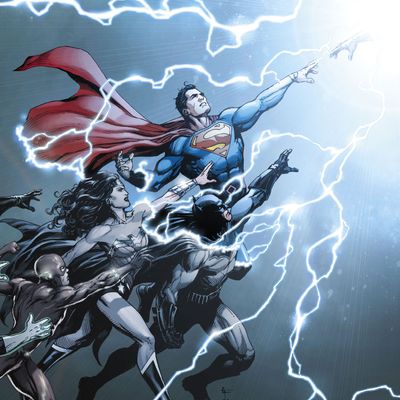
Ever since Captain America: Civil War passed the billion-dollar mark at the box office and, in so doing, coasted past Batman v Superman: Dawn of Justice’s $870 million take, there’s been a fair amount of mainstream-media discussion about the comparative supremacy of the Marvel-superhero brand over the DC-superhero brand. But the disparity extends beyond the cineplex: DC has also been desperately struggling to claw upward in the comics market from which it sprung.
Despite a brief burst of strength in 2011 when DC drew interest in its comics line by rebooting nearly all of its titles and setting them in a new universe where everyone was younger (and, therefore, less burdened by thorny continuity), the longtime publisher has generally lagged behind Marvel in recent years: Throughout 2016, Marvel has consistently held between 42 percent and 48 percent of the comics industry’s market share for units sold, while DC clocks in between 24 and 29 percent. But DC is banking on a much-buzzed-about project called Rebirth, which launches on Wednesday, to help close that gap. Details about Rebirth are finally trickling out, and it sounds like the company has reason to be cautiously optimistic.
The series isn’t a continuity reboot, per se; instead, it’s a kind of thematic pivot involving a crazy twist. It begins with DC Universe: Rebirth, a giant-sized standalone comic by writer (and DC Entertainment chief creative officer, as well as reported new co-head of DC’s film operations) Geoff Johns and a bevy of artists. It changes the post-2011 status quo significantly. But perhaps more importantly (at least in terms of grabbing eyeballs), it features a surprise ending that has the potential to snag attention from readers who don’t generally read superhero comics.
The plot is a little wonky, but the general idea is that it overrides the 2011 reboot and says more or less everything that’s ever happened in DC’s 70-plus-year history is on the table for future stories in DC books. It restores to continuity a lot of so-called “legacy characters”: folks who picked up mantles from existing figures (such as Wally West, the guy who became the new Flash after the death of his predecessor, and Ryan Choi, who did a similar thing for the Atom). These characters were popular with readers — though it’s hard to say if they were more popular than their forebears — and there was significant outcry when they were written out of continuity or otherwise sidelined.
There’s also a generally brighter tone to the comic than what we’ve seen in a lot of post-2011 DC series. Johns has a deep reverence for DC’s past, especially the stories told before the grim-and-gritty turn that the industry took in the late 1980s, and it shows in DC Universe: Rebirth. Old characters are put back into play by virtue of a cosmic reshuffling, but in a larger sense, it feels hopeful and optimistic, with an array of scenes in which individuals reflect on the love and friendship that has historically held them together.
But the moment that will have everyone talking — and already has, by virtue of a leak of Rebirth a few days ago — comes at the end. Even if you don’t generally peruse superhero stories, there’s a significant chance you’ve read or at least heard of Watchmen, the epochal mid-’80s self-contained miniseries by Alan Moore and Dave Gibbons. Dark and deconstructionist, it helped launch that grim-and-gritty turn. It wasn’t set in the mainstream DC universe (meaning Superman, Batman, and the rest were wholly absent and the world resembled our own); it was a critical smash; and it’s been in continuous printing for decades, meaning it’s often a comic that novices are given as an example of the medium’s potential. It also led to director Zack Snyder’s first DC movie effort, 2009’s somewhat successful film adaptation of the story.
So when, in the final few pages of Rebirth, it’s revealed that one of Watchmen’s main characters has been working behind the scenes to manipulate that aforementioned mainstream DC universe, it’s a big shakeup that could pique the interest of people outside the nerd inner-circle. We find out that a godlike being from Moore and Gibbons’s work, Dr. Manhattan, has been shaping events that affect all the DC heroes. It’s not entirely clear what he’s been doing, but it’s implied that he was the mastermind behind the 2011 reboot and all its attending darkness and brooding.
In effect, DC is breaking the unspoken rule that Watchmen is to remain in its own walled-off realm, which is a move that is both blasphemous and thrilling. Dr. Manhattan is also very explicitly framed here as a cynical contrast to all that is bright and aspirational in the DC mythos. A character says Manhattan’s appearance will lead to “a war between hope and despair. Love and apathy. Faith and disbelief.” But it also presages a new push in DC’s war against Marvel, one in which the former is aiming to audaciously turn the tide.

